
Electrically isolated water distiller
This page looks at the question, well, what is the simplest way to get safe water that will fit easily into a standard domestic kitchen?
The following discussion and tips are not ideal from the point of view of one who lives a completely different lifestyle from the suburban model for good reason, but the following will, I hope, provide a buy-it-and-plug-it-in clean water source for those of you in the suburban context where other options may not be easily attainable.
Background
You may have come here from the page on alternatives to tap water. There I assumed that water distillers with two pin plugs (double insulated) would be reasonably easy to come by. Not so, it seems. To get around that problem, the approach here is to electrically isolate the water distiller to achieve the same result.
Isolating transformer
Isolating transformers are just about as rare as double insulated water distillers! However, a nice man by the name of Daniel (his namesake was a decent bloke too) is making just the right thing in Australia, and if you follow this link to Tortech you'll find a 1000 watt isolation transformer on offer which can be plugged into any kitchen power point, and then any 600 watt distiller with a 3 pin plug can simply be plugged into the transformer to disconnect earth.
So, here is Tortech's part of the system:
Patience might be needed to find a good one of these. Cheap and nasty versions are relatively easy to find through the chain stores, but a good one should have a thick base, strong fittings and a lid:
Water distiller
Like the isolation transformer, this one can be ordered online.
With this arrangement we have a water distillation process not unlike that used in laboratories and hospitals. However, I'm no fan of distillers operated by AC electricity and in due course I'll add another page for a solar water distiller which works on evaporation.
Having come this far, it would be a shame to put our water in a saucepan on an earthed electric stove. Remember that we are aiming to avoid unsafe water and that means both for drinking and cooking.
So far my opinion is that there is ample epidemiological evidence to show that reticulated water is dangerous, and until there is some way of demonstrating that water heated on an earthed electric appliance is safe then it is best avoided.
Gas stove
Whether the gas bottle is inside or out is probably a choice made by your installer. Personally I prefer the bottle inside where I can turn off both the hob and the bottle. Any leak then becomes obvious if the gas is turned on at the ring before the bottle (if the line is empty, there is a leak). The bottle can be restrained under the bench in some way so that it can't be knocked over.
If the hob you choose has a pilot light, then the bottle is probably best outside.
Whistling kettle
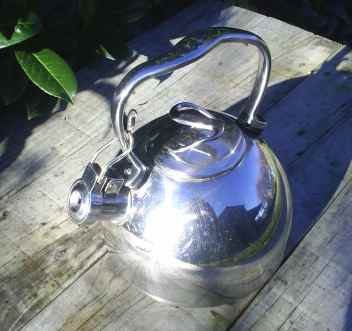
We've been using a whistling kettle for about 15 years, and the one on the left is our second. No plastic thingies to snap off!
The lid is useful for cleaning. In our case the bore water has a fair bit of lime in it, so the occasional clean is useful. Distilled water shouldn't require that of course!
There's no need to be pressured into buying a lemon: just use a sausepan in the meantime!
No prizes from Monstrosity and Garden but I dare say space could be found in the pantry or the appliance garage (shame on you) for both the isolater and the distiller.
Of course, if you use a distiller or other appliance of more than 600W then you'll probably need a larger isolating transformer. If you're thinking of power tools outside, then it may be a good idea to have a separate Tortech transformer for that purpose.
Try not to run it at full load.
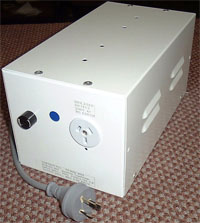
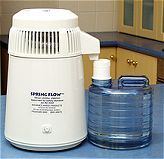
Following this link to steamdistiller.co.nz you'll find a 580W water distiller with enamelled outer.
This particular model appears under various brand names online and through hardware stores, plumbers supplies and so on, so chances are you can also buy it from a local shop even if they need to order it in for you.
The distiller holds around 4 litres of water, which should take about 6 hours to distil (perhaps allow overnight).
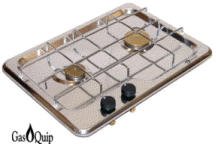
So, here we have a Gasquip two burner gas hob which can be obtained from selfpower.co.nz. You may need to google their homepage as there appears to be no link back.
With the controls shown this unit can be used either across (saves space) or along the bench. Gasquip can also supply the other bits and pieces if you're doing the work yourself.
As the water distiller is rather power hungry, a two burner hob is probably about right if we use 2 saucepans plus 2 steamers to avoid excess power use.
Another option is to use a very inexpensive cast iron gas burner such as Gasmate and tile an area on the bench as a heatproof surface.
What now?
In any case, the electric jug can now be retired in favour of a whistling kettle and a thermos can be used for drinks at work (well, what's the point of having good water at home and unsafe water at work!).
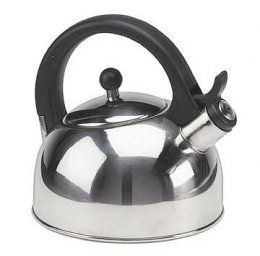
OK, so it has a plastic handle but it's quite presentable and will probably do the job admirably.
Smart Marine also have gas hobs and ovens. Having said that, however, the purpose of this page is not to encourage a spending spree but to point out a relatively simple conversion for a standard domestic kitchen: the path of least intervention, you might say.
Don't forget the thermos!
Stephen G. Butcher (04/07/08)
So that's about it. Use the distilled water for drinking (both hot drinks and cold) and for cooking. The water out of the kitchen taps can be relegated to washing the dishes, if you don't mind the smell.




